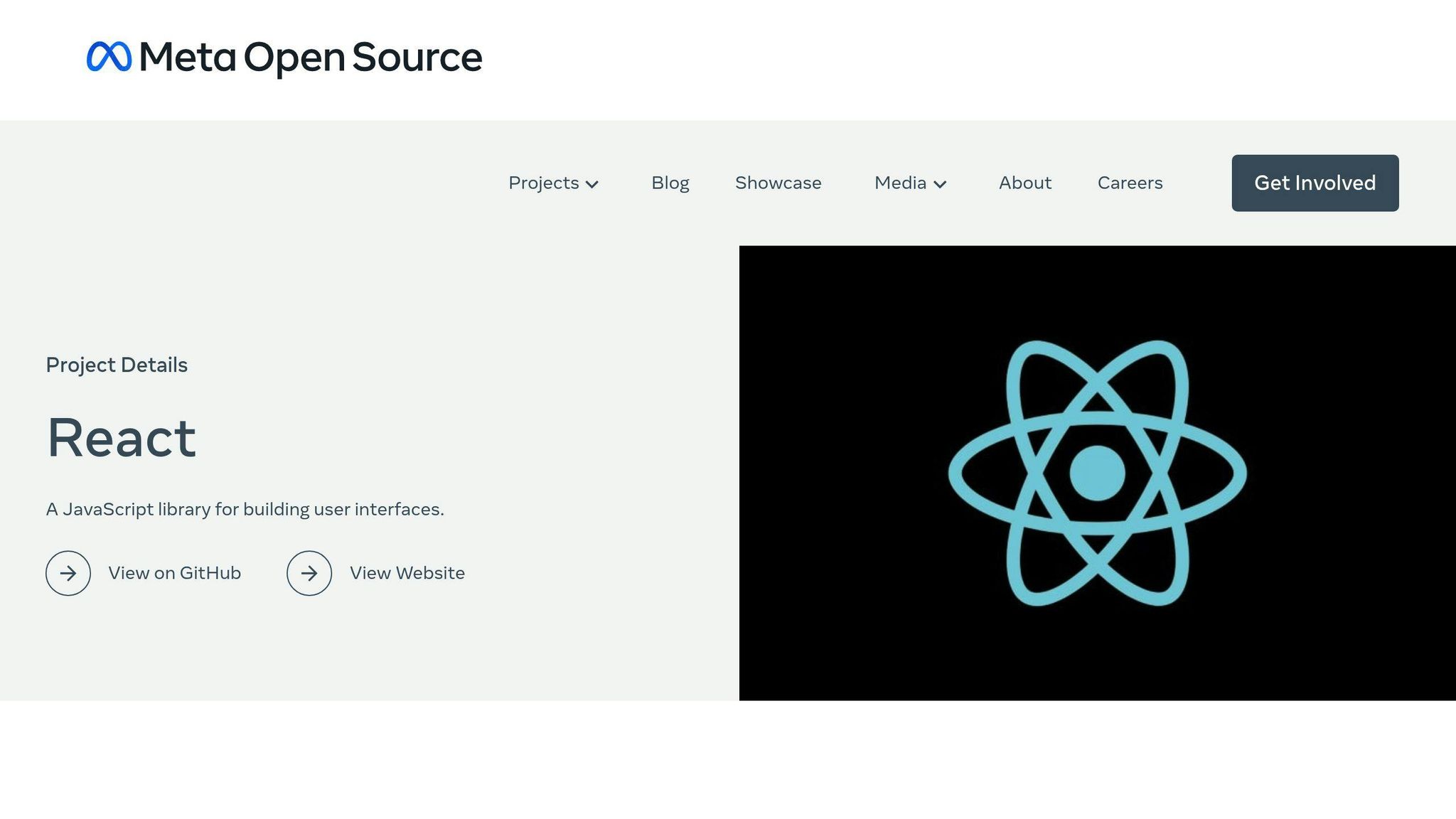React Components and Custom Elements are two popular tools for building reusable, modular web components. But which one should you choose?
Here’s the difference in a nutshell:
- React Components: Built with React, they use JSX and a virtual DOM for dynamic, data-driven UIs. Perfect for complex applications with frequent updates.
- Custom Elements: Part of the Web Components standard, they use native browser APIs and the Shadow DOM for encapsulated, framework-independent components.
Quick Comparison
| Feature | React Components | Custom Elements |
|---|---|---|
| Ecosystem | React-specific | Framework-agnostic |
| Browser Support | Requires React runtime | Native browser support |
| Encapsulation | React-based | Shadow DOM-based |
| Implementation | JavaScript/JSX | Standard HTML/JavaScript |
| Performance | Virtual DOM optimizations | Direct DOM manipulation |
| Reusability | Limited to React | Works across frameworks |
Key Takeaway:
Choose React Components for complex, data-driven apps and Custom Elements for lightweight, reusable components across frameworks – or combine both for a hybrid approach. Let’s dive deeper into how they work.
React vs Webcomponents – Which is Better?

React Components Basics
React Components are the building blocks of modern React applications, designed for creating reusable UI elements and functionality. They use JSX, a syntax extension that blends JavaScript with HTML-like code, to simplify UI development.
Core Concepts
React Components rely on three main principles:
- Props: Used to pass data from parent to child components.
- State: Manages local, dynamic data within a component.
- Unidirectional Data Flow: Ensures data flows in one direction, from parent to child, keeping updates predictable.
When data changes, React automatically updates the UI, making these components perfect for interactive applications.
Main Features
React Components offer several features that make them essential for modern web development:
| Feature | Description | Why It Matters |
|---|---|---|
| Virtual DOM | Efficiently updates the DOM | Speeds up rendering and performance |
| Component Reusability | Reusable across projects | Cuts down on code duplication |
| React Hooks | Simplifies state and lifecycle management | Keeps code clean and organized |
| Hot Reloading | Updates components instantly during development | Saves time in development cycles |
Building a React Component
To create a React Component, write a function that returns JSX. Here’s an example of a reusable button component:
import React, { useState } from 'react'; function CustomButton({ label, onClick }) { const [isHovered, setIsHovered] = useState(false); return ( <button onClick={onClick} onMouseEnter={() => setIsHovered(true)} onMouseLeave={() => setIsHovered(false)} style={{ backgroundColor: isHovered ? '#0056b3' : '#007bff', padding: '10px 20px', border: 'none', borderRadius: '4px', color: 'white', transition: 'background-color 0.3s' }} > {label} </button> ); } This example highlights several key aspects:
- State management: Tracks whether the button is hovered.
- Props: Allows customization via
labelandonClick. - Event handling: Responds to mouse events.
- Dynamic styling: Changes appearance based on the state.
By focusing each component on a single task, you can improve performance, simplify debugging, and make your app easier to scale. This modular approach is a core principle of React’s architecture.
Next, we’ll dive into Custom Elements to see how they compare in functionality and use cases.
Custom Elements Explained
Custom Elements are a key feature of the Web Components specification. They allow developers to create reusable, independent components that work across various frameworks, making them a powerful tool for modern UI/UX design.
How Custom Elements Work
Custom Elements are built using three main technologies: the Custom Elements API for defining new tags, the Shadow DOM for encapsulating styles and markup, and HTML Templates for reusable structures. As of 2023, they enjoy widespread browser support, covering 94.5% globally.
Why Use Custom Elements?
| Feature | Description | Benefit |
|---|---|---|
| Framework Independence | Compatible with React, Angular, Vue, and others | Simplifies integration and reduces development time |
| Encapsulated Styles | Shadow DOM ensures styles don’t leak | Keeps CSS clean and improves maintainability |
| Native Browser Support | No additional runtime needed | Boosts performance and reduces dependencies |
Example: Creating a Custom Element
Here’s a quick example of how to create a custom button with encapsulated styles and behavior:
class CustomButton extends HTMLElement { constructor() { super(); const shadow = this.attachShadow({ mode: 'open' }); shadow.innerHTML = ` <style> button { background: #eee; padding: 12px; border-radius: 4px; border: none; transition: background 0.3s; } button:hover { background: #ddd; } </style> <button><slot></slot></button> `; } } customElements.define('custom-button', CustomButton); To use this button, simply add the following to your HTML:
<custom-button>Click me</custom-button> The Shadow DOM ensures that the button’s styles are isolated, eliminating conflicts with other elements on the page. Keep in mind that custom elements must have hyphenated names to differentiate them from native HTML tags.
Next, we’ll dive into how Custom Elements stack up against React Components in terms of performance, compatibility, and the developer experience.
React vs Custom Elements
React Components and Custom Elements take different paths to achieve component-based development. Each comes with its own set of strengths and trade-offs, impacting how they’re implemented and used.
Performance and Compatibility
React relies on the Virtual DOM for rendering, while Custom Elements work directly with the DOM. Here’s a comparison:
| Aspect | React Components | Custom Elements |
|---|---|---|
| Resource Usage | React runtime adds memory and load time overhead | Native APIs reduce resource demands |
| Rendering Speed | Virtual DOM diffing boosts efficiency | Direct DOM manipulation |
| Bundle Size | Includes React library | No added bundle size |
When it comes to browser compatibility, Custom Elements have broad native support, covering 94.5% of browsers globally. However, React addresses compatibility through its runtime, making it consistent across modern browsers. Custom Elements might need polyfills for older browsers.
React Components:
- Seamlessly work across modern browsers
- Polyfills are only needed for older features
- React runtime ensures compatibility
Custom Elements:
- Supported natively in Chrome, Firefox, Safari, and Edge
- Polyfills are required for older browsers
- Shadow DOM behavior can differ slightly between browsers
Development Experience
React is backed by a rich ecosystem of tools and resources, making it easier to manage state with hooks and props. Debugging is supported by tools like React DevTools and Redux. On the other hand, Custom Elements integrate directly with the browser but require manual state management and debugging through standard browser tools.
React’s ecosystem is ideal for building complex applications, offering robust tools and workflows. Custom Elements, however, shine when you need reusable, framework-independent components that fit seamlessly into any web project.
Choosing between React and Custom Elements depends on your project’s needs. React’s ecosystem is better suited for large, intricate applications, while Custom Elements are great for lightweight, framework-agnostic solutions. In some cases, combining both can offer the best of both worlds.
sbb-itb-f6354c6
Using Both Technologies Together
Combining React Components with Custom Elements opens up a world of possibilities for modern web development. This approach lets developers take advantage of both tools, ensuring reusable code and optimized performance.
Custom Elements in React Projects
Using Custom Elements in React apps requires careful setup, especially regarding component lifecycle management. Here’s an example of how to implement this:
import React from 'react'; import './custom-button'; function ProductCard() { const handleClick = (e) => { console.log('Button clicked:', e.detail); }; // Handle Custom Element events using standard DOM event listeners return ( <div className="product-wrapper"> <custom-button onButtonClick={handleClick} label="Add to Cart"> </custom-button> </div> ); } To make the integration seamless, pay attention to these aspects:
| Integration Aspect | Details |
|---|---|
| Event Handling | Use standard DOM event listeners for communication |
| Props and State | Map React props to Custom Element attributes and ensure state consistency |
| Style Management | Leverage Shadow DOM to avoid style conflicts |
React Components as Custom Elements
Transforming React Components into Custom Elements allows them to be used in other frameworks or plain JavaScript projects:
class ReactWrapper extends HTMLElement { connectedCallback() { const mountPoint = document.createElement('div'); this.attachShadow({ mode: 'open' }).appendChild(mountPoint); const name = this.getAttribute('name'); ReactDOM.render( <ReactComponent name={name} />, mountPoint ); } } customElements.define('react-wrapper', ReactWrapper); When applying this method, ensure the following:
- Set up proper event handling for communication between React and Custom Elements.
- Synchronize React props with Custom Element attributes.
- Monitor rendering to avoid unnecessary updates and maintain performance.
This hybrid approach allows developers to address the limitations of each technology, offering scalable solutions for complex projects. It’s especially helpful in large-scale applications where teams might rely on different tools or frameworks.
Making the Right Choice
Choosing between React Components and Custom Elements depends on your project’s needs, your team’s skills, and how you plan to maintain the application over time.
When to Use React
React Components are a great fit for projects that involve complex, dynamic interfaces requiring advanced state management and frequent updates. Some scenarios where React stands out include:
| Scenario | Why Choose React |
|---|---|
| Single-Page Applications | Offers optimized performance with built-in state management and virtual DOM |
| Complex User Interfaces | Access to a wide range of UI libraries and tools |
| Large Development Teams | Well-documented patterns and extensive community support |
| Rapid Prototyping | Reusable components allow for faster iterations |
React’s ecosystem is mature and well-suited for enterprise-level applications. For example, building data-heavy dashboards or real-time collaboration tools benefits significantly from React’s efficient rendering and state-handling capabilities. However, while React is excellent for complex apps, there are cases where Custom Elements might be a better fit.
When to Use Custom Elements
Custom Elements are ideal for developing reusable components that work across various frameworks. They’re particularly useful in the following scenarios:
| Use Case | Why Choose Custom Elements |
|---|---|
| Cross-Framework Components | Native browser support ensures compatibility with any framework |
| Design Systems | Shadow DOM provides consistent styling and encapsulation |
| Standalone Widgets | Self-contained functionality without framework dependencies |
| Performance-Critical Elements | Direct access to browser APIs ensures faster execution |
Key Factors to Consider
When deciding which technology to use, keep these points in mind:
1. Project Size and Complexity
For large, intricate applications with significant state management needs, React is often the better choice. Custom Elements, on the other hand, are more suitable for smaller, standalone components or design systems.
2. Team Skillset
Your team’s expertise plays a big role. If your developers are already familiar with React, transitioning to Custom Elements could require additional training.
3. Performance and Compatibility
Custom Elements use native browser features for faster performance and better memory efficiency, making them easy to integrate across different frameworks. React’s virtual DOM, however, may perform better for apps with frequent state changes.
4. Future Maintenance
Think about how your choice will affect long-term maintenance. Custom Elements are less tied to specific frameworks, offering more flexibility as technologies evolve. React, meanwhile, provides a stable and well-supported ecosystem for ongoing development.
Ultimately, the best choice depends on your project’s specific goals and constraints. Keep in mind that these technologies can also be combined for hybrid solutions, as mentioned earlier.
Summary and Next Steps
Let’s break down practical steps for using React Components, Custom Elements, or a mix of both in your projects.
Getting Started with Implementation
Deciding between React Components and Custom Elements shapes your development workflow. Here’s a quick guide:
| Technology | Initial Setup | Key Steps |
|---|---|---|
| React Components | Use tools like Create React App or Next.js | Configure JSX, set up state management |
| Custom Elements | Work with Vanilla JavaScript | Register elements, define shadow DOM |
| Hybrid Approach | Combine React with Web Components | Configure bundlers, set up interop |
Development Roadmap
Before diving in, assess your project’s needs, such as browser compatibility, team expertise, and performance targets. Then, follow these steps:
- Environment Setup
- Choose the right tools and configure them for your chosen technology.
- Set up build processes and add necessary dependencies.
- Implement testing frameworks to ensure quality.
- Integration Strategy
- Enable smooth communication and isolation between components.
- Define clear interaction patterns for your components.
- Plan how data will flow across your application.
Performance Optimization
To keep your app running smoothly, focus on these areas:
| Focus Area | Strategy |
|---|---|
| Initial Load | Use lazy loading and code splitting |
| Runtime Performance | Optimize rendering and state updates |
| Memory Management | Manage component lifecycles effectively |
Continuous Improvement
Keep learning from official documentation and community updates. Both React and Web Components are evolving, offering fresh ways to create efficient user interfaces. Pick the best fit for your project and start building scalable components today.
FAQs
What is the difference between web component and React component?
Web Components and React Components serve different purposes, with distinct architectures and use cases. Let’s break down their key differences:
| Aspect | Web Components | React Components |
|---|---|---|
| Technology Base | Built on native browser APIs | Powered by a JavaScript library |
| Encapsulation | Uses Shadow DOM for isolation | Relies on Virtual DOM |
| Reusability | Works across any framework | Limited to React ecosystem |
| State Management | Requires manual handling | Offers built-in lifecycle methods |
| Styling | Scoped CSS via Shadow DOM | Global CSS or CSS-in-JS |
Here’s a quick example of a Web Component with encapsulated styling:
class TestElement extends HTMLElement { constructor() { super(); const shadowRoot = this.attachShadow({ mode: 'open' }); shadowRoot.innerHTML = `<div><p>Hello ${this.getAttribute('name')}!</p></div>`; } } customElements.define('test-element', TestElement); Web Components work well for:
- Independence from frameworks
- Strong style isolation
- Seamless integration with HTML
React Components shine when you need:
- Advanced state handling
- Access to a vast library ecosystem
- Faster development workflows
Both have their place and can even be combined in hybrid projects, depending on your team’s skills and the project’s needs. Choosing the right one depends on what you’re building, who’s building it, and how you plan to scale.

